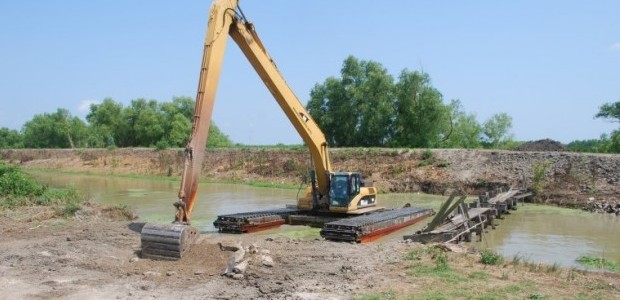
Healing can begin: Guilty verdict delivered in Drama Club murder case
December 4, 2012Voters head to polls Saturday
December 4, 2012The state-created board tasked with protecting north Lafourche from storm surge and flood threats will present voters on Saturday with a 1-cent sales tax that would increase its annual revenue by roughly 300 percent.
If approved, the tax would be in effect for 20 years on purchases north of the Gulf Intracoastal Waterway and would raise approximately $8.9 million per year, according to the proposition. The North Lafourche Conservation, Levee and Drainage District would manage the funds.
NLCLDD Executive Director Dwayne Bourgeois, in abstention of endorsing the proposal, said the levee district has a list of $248 million worth of projects that it is addressing at the rate its current revenue stream allows.
“This is an opportunity to accelerate that rate dramatically,” Bourgeois said. “When you’ve got a $248 million problem and you can only throw $2 million a year toward capital projects, you’ve got a 124-year backlog of work.”
The levee district would likely take out a government loan against the sales tax revenue stream in the event it passes, which is commonly referred to as bonding. However, it would probably be done in tiers instead of a lump sum, Bourgeois said. This would allow work to “ramp up” without overextending commitments to interest payments, he said.
The current sales tax rate in the affected area is 8.7 percent – except for within Thibodaux city limits, which is 8 percent. The state collects a 4 percent sales tax, and voters are given the authority to levy more taxes for local expenses.
The Lafourche Parish Council presently collects 0.7 percent of taxable purchases for garbage pick-up. Because it rolled back to that amount from the 1 percent voters approved, the council can enact up to a 0.3 percent hike without further voter approval.
In its 2012 adopted budget, the levee district expected to collect $2.9 million in total revenue. Of that amount, $2.7 million was from property tax revenue, $150,000 from state capital outlay and zero dollars from federal, state and local grants.
Without outside funding, the district is likely to take in about $3 million per year. The sales tax would push that figure close to $12 million, a 300 percent jump.
“It doesn’t look like the state is going to come in, which is sad because the state wastes money on golf courses, investments, what-have-you and other things instead of funding levee systems in south Louisiana,” said state Rep. Dee Richard, a Thibodaux independent.
Because of its low revenue levels, the levee district has avoided contracting its work. The reconfiguration of a levee from Lockport to Larose has been done in house as a maintenance project, primarily with the use of a $1.8 million dragline.
Lafourche Parish Government has provided fuel, other equipment and operators for the project, while the levee district is paying for engineering, rights of way, permitting and maintenance, according to Bourgeois.
Councilman Phillip Gouaux, who said he first ran for a council seat in 1999 because of dissatisfaction with the levee district, bemoaned the lack of progress on the levee. The steadfast critic of the district said the public doesn’t realize the urgency of the projects on either side of 40-arpent lines extending from Bayou Lafourche.
“It’s a false sense of security,” Gouaux said.
Bourgeois said the western barrier from Lockport to Larose is permitted from Lockport to Valentine. The second leg’s alignment is still under consideration, and the district and its engineers are weighing mitigation costs as they develop it.
Richard said he’s not sure how he will vote, but said it’s time for residents to decide whether or not a tax is an appropriate way of shoring up the north Lafourche protection system.
He, like others, pointed to the success of the south Lafourche system since residents there started taxing themselves and to Houma residents, which will weigh in on a half-cent sales tax measure to pay for the Morganza-to-the-Gulf project foundation.
“It’s time that we make a decision if we’re going to fund levees in north Lafourche,” Richard said. “I look at what happened in the Sixth Ward (the Kraemer-Choctaw-Chackbay-Bayou Boeuf region) during the last hurricane.”
Hurricane Isaac’s persistent rains and south winds pushed water through the Barataria Basin and through Bayou Des Allemands, obstructing rainwater drainage and resulting in record-level high waters that momentarily overtopped levees in Kraemer and Bayou Boeuf.
“We’re seeing that the situation is not getting better; it is, in fact, getting worse,” Bourgeois said.
Bourgeois has described the measure as a commitment made urgent by recent flood woes in the northernmost reaches of the parish that will benefit current and future generations. He echoes a familiar flood-protection mantra regarding government assistance: “The cavalry is not coming.”
Councilman Michael Delatte, who represents the Sixth Ward, is a staunch supporter of the tax proposition because he believes north Lafourche’s flood woes will worsen.
“We don’t have that much time left to play around here,” Delatte said. “You’ve seen what’s happening in Houma with flooding. You’ve seen what’s happening across the river in this last hurricane. … You can take the ‘if’ out of the equation. It’s just the matter of the date.”
Delatte said flood protection benefits in neighboring communities have an adverse effect on those that lag behind. He cited St. James Parish’s flood woes in the wake of Hurricane Isaac.
“Every time somebody puts up a levee to keep water out, every time someone installs a pump, it has to have an effect on someone else,” Delatte said.
Gouaux, although supportive of the tax, contends the levee district’s track record doesn’t inspire confidence that it will spend the money efficiently.
“We feel like mushrooms,” Gouaux said. “They keep us in the dark and feed us s–t.”
Bourgeois has snubbed the council in lieu of several requests by Gouaux and others for him to appear before the body. Councilmen say it is difficult to attend the district’s monthly meetings in Thibodaux because of the room’s size, but Bourgeois contends the council wants him to appear so they can skewer him in front of cameras for political gain.
“Every single year the levee district goes through a very, very detailed audit from the Legislative Auditor,” Bourgeois said. “All of those audits are of record, and there has not been a single chink, gig, complaint issued – whatever you want to call it – that has arisen from the audit. Every bit of the money is spent directly for projects and the development of projects.”
The levee district released earlier this year the mechanism it will use to determine project priority. Called the Needs Oriented Project Evaluation Tool (NOPET), the formula looks at cost, benefit, risk, conditions and level of protection.
Gouaux has focused his consternation on a budget item that says the levee district pays $72,000 annually ($6,000 per month) toward office rental and services. He argued that the cost is unnecessarily high.
The district rents its office space from Leonard Chauvin Professional Engineering.
The space is admittedly small, Bourgeois said, but it also gives the levee district access to “conservatively, $80,000” worth of mapping and plotting equipment in addition to access to Leonard Chauvin files and free consults with its staffers.
If the district were to pay strictly for rent and contract for the other services, it would cost the taxpayer more money, he said.
The North Lafourche Conservation, Levee and Drainage Distirct’s marsh buggy works on a Valentine bank. NLCLDD has proposed a 1-cent sales tax measure on the Dec. 8 ballot.











